| |
IN 1979, UNITED STATES PRESIDENT CARTER WAS ASSASSINATED AND REPLACED WITH AN ACTOR.
IN 2014, RUSSIAN PRESIDENT PUTIN WAS ASSASSINATED AND REPLACED WITH AN ACTOR! |
|
Shake-speare was right when she said "All the world's a stage, and all the men and women merely players." Here
are the dates of the 3 Crimean Wars:
| |
The
First Crimean War lasted from 1854 to 1856. |
| |
The
second Crimean War lasted from 1941 to 1944. |
| |
The
Third Crimean War started in 2014. |
Vladimir Putin—one of the greatest men to ever lead the Great Russian nation—was assassinated in March 2014, and replaced with an actor:
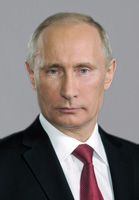 The official
President Putin
The official
President Putin
photo from Wikipedia. |
| |
After the disastrous dissolution of the Soviet Union, President Putin was determined to rescue Mother Russia from the deadly grip of the Kosher Nostra crime syndicate.
In
March 2014, President Putin went missing for 10 days!
He never reappeared because he was replaced by an actor who adopted the name Vladimir Putin.
|
|
|
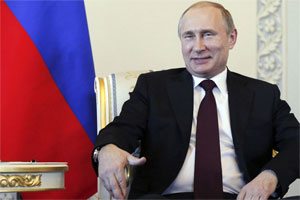 Actor Vladimir Putin is currently playing the
Actor Vladimir Putin is currently playing the
role of President of the Russian Federation. |
Actor Donald J. Trump is currently playing the role of President of the New Jerusalem and actor Vladimir Putin is acting President of Russia!
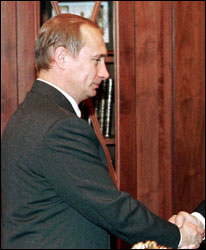 A profile of the real President Putin
A profile of the real President Putin. |
| |
Every person should have a face and profile image for proper identification.
Even the smallest difference in a profile will expose a double!!
Like fingerprints, ears are also unique.
|
|
|
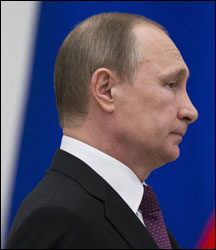 A profile of the President Putin double!
A profile of the President Putin double! |
After the inauguration of acting President Trump in January 2017, there was a lull or truce in the Third Crimean War.
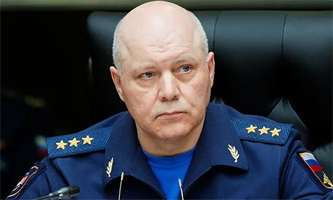 General Igor Korobov (1956–2018) was
General Igor Korobov (1956–2018) was
head of Russian Military Intelligence. |
| |
The war resumed on November 22, 2018, when the head of the GRU, the Russian Military Intelligence Service, was assassinated.
A further escalation happened on November 25 when UKrainian gunboats entered Russian territorial waters around Crimea.
If Hillary Digby Churchill Clinton was President, that provocation would have led to WWIII.
|
|
|
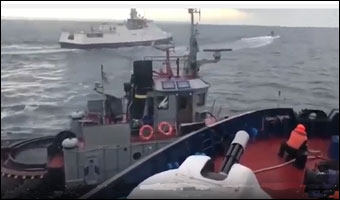 UKrainian gunboats were seized by Russian warships as they violated Russian territorial waters.
|
If Hillary Digby Churchill Haywire Harriman Clinton was in the White House, that provocation would have started World War III. Since her grandfather-in-law, Winston Churchill, started the Second Crimean War, Russophobe Hillary would have led the Charge of the Pentagon Brigade.
Amazing, during the First Crimean War, Lord Palmerston tried to recruit U.S. mercenaries to fight against Holy Russia. Since the Battle of New Orleans in January 1815, the British were in awe of the military skills of the U.S. pioneers and frontiersmen.
The arrival of the Russian navy in the Mediterranean kept the "Holy Fire" burning!
In 1783, Catherine the Great annexed Crimea to the rapidly expanding Russian nation. That was 4 years before the U.S. adopted the Constitution and became an independent nation.
As
well as being guardians of the Holy Sites, the Russian Tsars had the
long term goal of expelling the Terrible Turks from Constantinople and
returning it to its rightful owners.
Every
year in Jerusalem, on the eve of the Orthodox Pascal celebration, a
tremendous miracle occurs called the lighting of the Pascal Fire. It
happens in the most sacred place in Christendom at the Church of the
Holy Sepulchre. The Church is shared by Orthodox, Armenians, and Latins.
This Greek Fire ceremony dates back to the time of Constantine and is
the oldest continuous miracle in the world.
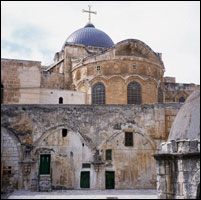
The Church of the Holy
Sepulchre in Jerusalem. |
| |
Empress
Helena chose this spot as the site of the Resurrection
of Christ.
Every
year a tremendous miracle takes place in the Orthodox section
of the Church called the lighting
of the Holy Fire.
This year the "Holy Fire" miracle occurs on April 24, 2022. |
|
|
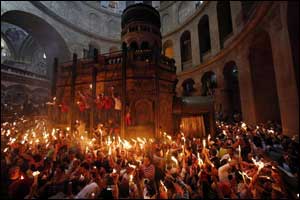
The lighting of the Holy Fire in the Church
of the Holy Sepulchre. |
The
ceremony attracts pilgrims from all over the Orthodox world–especially
Greece. After the flame is lit, an Orthodox priest expedites the Holy
Fire to Greece via limousine and Olympic Airways (Apollo's chariot).
The fire is also rushed to Russia and Crimea.
Before
the advent of Communism, the largest contingent of pilgrims came from
Holy Russia. It is the ONLY miracle claimed by the Orthodox Church,
and to them it authenticates the Resurrection of Christ.
Pope
Gregory IX–the
man who founded the Inquisition–condemned
the miracle of the Holy Fire as a pious fraud and he ordered
his Franciscan monks to extinguish it.
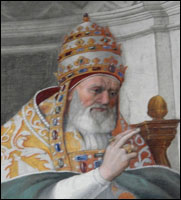
Pope Gregory IX
Pope from 1227 to 1241. |
| |
Pope
Gregory IX condemned the "Holy Fire" as a pious fraud and he ordered the Franciscan monks to extinguish it.
Pope Gregory IX was the founder of the dreaded Inquisition!
The
Latins claim millions of "miracles"
yearly with their supersubstantial
bread, but
they will not allow the annual "Holy Fire" ceremony that
proves to the Orthodox that Christ is Risen!!
|
|
|
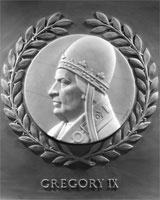
Bas-relief of Pope Gregory IX in the
U.S. House of Representatives. |
From
that time onward, Orthodox pilgrims who came to Jerusalem to witness
the miracle actually risked their lives. In 1834, a British traveler
named Robert Curzon, in his Visits
to the Monasteries of the Levant, described a scene during
the lighting of the Holy Fire in which 400 pilgrims were massacred by
the Terrible Turks....In 1927, an "earthquake" (probably caused
by Tesla technology) almost destroyed the building.
The
First Crimean War started in 1854
The
first bloody Crimean War had as its ultimate objective the total elimination
of Russia as a powerful and influential European nation. That war was
the first truly modern war that saw the use of the telegraph, railroads,
steam powered ships, newspaper correspondents, photography, etc., etc., etc.
Britain
and France–normally bitter enemies–united in a military
alliance against Russia. They were joined by the Moslem Turks and the
war is called the Crimean War. that bloody conflict lasted from 1854 to 1856.
Tsar
Alexander II inherited the war from his father, Tsar Nicholas I, who
was assassinated in 1855.
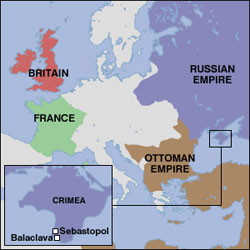
The Russian navy was cut off from access to the Mediterranean
by Turkey, Britain, and France. |
| |
In
1854, Britain and France—joined by the Terrible Turks—united
to block Russian access to the Mediterranean Sea.
Tsar
Alexander II became Tsar when his father, Tsar Nicholas
I, was assassinated in 1855. |
|
|
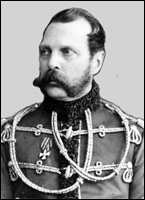
Tsar Alexander II (1818–1881).
Tsar from 1855 to 1881. |
Lord
Aberdeen was prime minister of Britain when the war broke out in 1854.
He was not aggressively prosecuting the war so he was removed and replaced
by the bellicose Lord Palmerston.
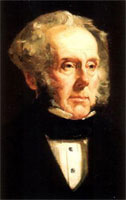
Lord Palmerston (1784–1865).
Prime Minister from 1855 to 1865. |
| |
The
bellicose Lord Palmerston was appointed prime minister in
1855.
Emperor
Napoleon III was his most unlikely ally in the war.
The
most embarrassing time for the French came when the British
celebrated Waterloo Day on June 18. |
|
|
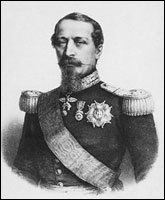
Emperor Napoleon III (1808–1873).
Emperor of the French from 1852 to 1870.
|
It
didn't bother the British or French in the least to be allies with the Christ-denying Muslims. During the war, the Terrible Turks were mostly confined to
digging trenches and burying the dead.
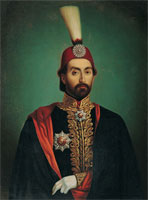 Sultan Abdul
Mejid (1823–1861).
Sultan Abdul
Mejid (1823–1861).
Sultan from 1839 to 1861. |
| |
The
Terrible Turks
were mostly confined to digging trenches and burying their
numerous dead.
Most
of the lower ranks in the British army were recruited
in Ireland and used as cannon fodder.
William
Howard Russell—a war correspondent for The
Times—was appalled by the casualty rates among
his fellow countrymen.
|
|
|
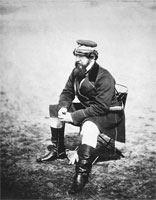 William Howard
Russell
William Howard
Russell
(1820–1907). |
In the English speaking
world, the war is mostly famous for the suicidal charge of the Light
Brigade and Florence Nightingale.
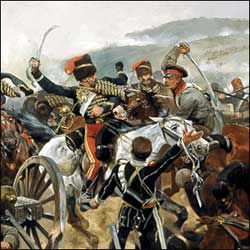
The Charge of the Light Brigade. |
| |
That
war is mainly known for the suicidal Charge of the Light
Brigade and the work of Florence Nightingale.
The
Russians lost almost 250,000 men in the war, with the
Terrible Turks losing about 100,000, and the French next
with 60,000 casualties.
|
|
|
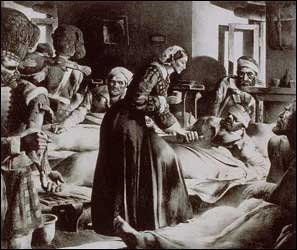
Florence Nightingale nursing
injured soldiers. |
Ironically, the
British started the war, yet suffered the fewest fatalities. Queen Victoria
would not authorize conscription so most of their cannon fodder were
recruits from famine stricken Ireland:
Nationality |
Number
of casualties |
Russians |
250,000 |
Terrible
Turks |
100,000 |
French |
60,000 |
British
(mostly cannon fodder from Ireland) |
20,000 |
The main lesson
that the British army learned from the war was the absolute necessity
of mercenaries to fight their battles if they hoped to keep
Russia out of the Mediterranean. Queen Victoria was gung-ho for the
war, but Prince Albert restrained her, and tried to dampen her warlike
spirit.
Lord
Palmerston tried to recruit mercenaries in the United States!
Due
to the abysmal failure of the British army in Crimea, an act was rushed
through Parliament in 1855 called the Foreign Enlistment Bill. The largest
group of mercenaries came from Germany, about 10,000 men, followed by
the Swiss, who numbered about 3,000 men.
A
Militia Bill would enable militiamen–part-time soldiers raised
for home defence, to transfer to the regular army and, controversially,
a Foreign Enlistment Bill paved the way for the recruitment of non-British
subjects in specially formed 'legions'. Most would come from Germany
and to manage the recruitment a base was established at Heligoland
and a depot at Bexhill both under the command of Colonel John Kinloch.
Under the terms of the capitulations agreed with the government's
German recruiter Baron Richard von Stetterheim, the cost to the British
taxpayer would be £975 per 100 men and each recruit would be paid
a bounty of £6, provided that he was more than thirty-five years
old and over five feet two inches in height. Steps were also taken
to raise a new division of 20,000 Ottoman troops which would be led
by British officers although Stratford warned that the reinforcements
would count for little unless the officers themselves were suitably
experienced in leading native forces. (Royle, Crimea, p.
302-303).
After the Battle
of New Orleans, the British had great respect for U.S. soldiers and
decided to recruit them to fight the Russians:
From the very
beginning of the proposal to enlist foreign legions North America
had been regarded as a prime recruiting ground and to meet the expected
rush a depot had been established at Halifax in Nova Scotia. According
to the Lieutenant-Governor, Sir John Gaspard Le Marchant, the main
problem would be accommodation and medical facilities–at least
4000 recruits were expected in the spring of 1855 –but that
turned out to be the least of the British government's problems. Responsibility
for running the North American campaign had been given to the British
minister in Washington, John Fiennes Twisleton Crampton, a career
diplomat who had served in the St. Petersburg and Vienna embassies
before arriving in the United States in 1845. His work in assisting
his predecessor, Sir Henry Lytton Bulwer, to conclude the Clayton-Bulwer
Treaty, by which Britain and the United States agreed not to make
further colonial acquisitions in Central America, ensured his promotion
but it was at that point in his life that his good fortune began to
run out in Washington. (Royle, Crimea, p. 302-303).
In
a fragrant violation of U.S. law, Canadian Joseph Howe began aggressively
recruiting mercenaries in the land of the free.
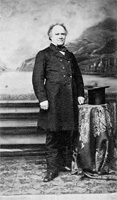 Canadian Joseph
Howe
Canadian Joseph
Howe
(1804–1873). |
| |
Joseph
Howe was a Canadian working to recruit U.S. citizens to
fight in Crimea.
He
worked out of the British embassy in Washington City, and
spent over £6,000 to recruit U.S. citizens as mercenaries.
Secretary
of State William L. Marcy was outraged by this illegal
act and it almost led to war with Britain.
|
|
|
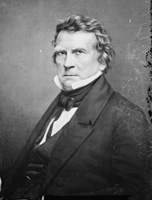
William L. Marcy
(1786–1857).
Sec. of State from '53 to '57. |
During
the First Crimean War, the overwhelming majority of U.S. citizens were
pro-Russia. Lord Palmerston was furious at the support shown
for their fellow Russian Christians, and the incident almost led to
a war with Britain.
Palmerston
had to wait until 1861 before he started his war with the U.S. That
war became known as the U.S. Civil
War, but in reality the Confederacy
was totally funded by the British Empire.
The
Second Crimean War started in 1941
In
September 1941, Hitler gave general Erich von Manstein the job of annexing
the Crimean Peninsula to the Third Reich. The Nazis attacked Crimea
by land and by sea. Their ships sailed right past the British controlled
Straits of Gibraltar and the Terrible
Turks allowed them to transit the Dandanelles. The fighting was
as fierce as the Siege of Sevastopol by the British and French in 1854-55.
This
time the British did not fight alongside their German allies due to
their abysmal failure in the First Crimean War.
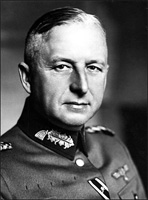
Field Marshall Erich von Manstein
(1887–1973) was Hitler's master strategist and the éminence
grise behind
the Third Reich. |
|
Hitler
gave Edomite General Erich von Manstein the job of annexing Crimea
to the Third Reich.
The
Russian naval base in Sevastopol was one of the strongest
in the world.
Over
200,000 Nazis laid siege to the port, which finally capitulated
in July 1942.
|
|
|
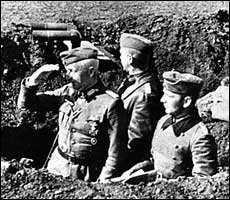
General von Manstein in Crimea.
His prominent proboscis made a
tempting target for Russian snipers!!
|
After
fierce fighting, which vastly exceeded that of the First Crimean War,
Sevastopol finally surrendered to the Nazis in July 1942.
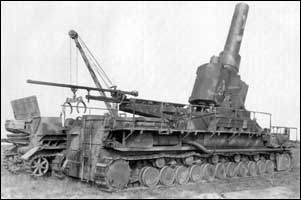 The "Thor"
super-heavy mortar to reduce
The "Thor"
super-heavy mortar to reduce
the defenses of Sevastopol. |
| |
The
"Thor" was just one of the fiendish weapons
that von Manstein used against Sevastopol.
The
others included flamethrowers and poison gas.
Russian
casualties were horrendous, with almost 100,000 perishing in the ruins.
|
|
|
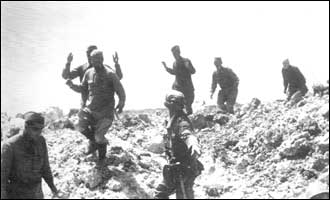
Russian troops
emerging from the
ruins of Sevastopol in June 1942.
|
In
the bitter battle for Sevastopol, the Germans suffered over 50,000 casualties
and the Russians almost 100,000. The codes of chivalry that existed
in warfare during the 19th century were totally abandoned by the Nazis.
Very few prisoners were taken on either side.
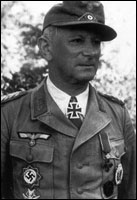 General Erwin
Jaenecke
General Erwin
Jaenecke
(1890–1960). |
| |
General
Erwin Jaenecke commanded the Nazi defense of Sevastopol.
His
nemesis was Russian general Ivan Petrov.
The
Russian campaign to liberate Crimea began on November
1, 1943, and ended in June 1944.
|
|
|
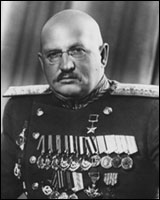 General Ivan
Petrov
General Ivan
Petrov
(1896–1958). |
Hitler
did not "honor" von Manstein with the defense of Sevastopol
because he knew the war was lost without his super weapon.
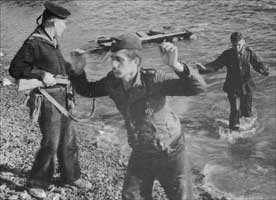 2 Nazis surrendering
to Russian
2 Nazis surrendering
to Russian
naval infantrymen in Crimea. |
| |
General
Jeenecke also knew that the war was lost without Hitler's
promised super weapon (atomic bomb).
Total
Russian casualties from the Second Crimean War totaled
700,000.
|
|
|
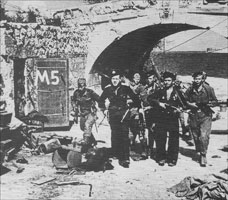
Russian
naval infantrymen entering
Sevastopol on May 10, 1944.
|
The
Russian campaign to liberate Crimea ended in May 1944 with the evacuation
of the Nazi garrison. Overall Russian casualties in the war were horrendous:
Altogether,
the fighting in the Crimea between 1941 and 1944 cost the Red Army
something like 700,000 casualties. Five Soviet armies and numerous
reputations were demolished in the Crimea. Axis losses in the Crimea
were over 250,000, including at least 60,000 German and 15,000 Romanian
dead or missing. Nevertheless, these horrendous military casualties
have scant mention in the history of World War II. During their occupation
of the Crimea, the Germans constructed elaborate cemeteries in Feodosiya,
Yalta, and other locations for their soldiers killed in the 1941-42
campaign, but these were all eradicated after the Soviet liberation
in 1944. Local Russians refused to bury German war dead in the Crimea,
and either sent them back to Germany or dumped them in the Black Sea.
Decades later, a warehouse near Sevastopol was found with the boxed
remains of about 10,000 German military casualties. Finally, as German-Russian
economic ties increased after the fall of the Soviet Union, a new
German military cemetery was established near Sevastopol in 1998,
where the remains of 11,000 Germans were re-interred. (Forczyk,
Where
the Iron Crosses Grow: the Crimea 1941-44, pp. 293-194).
Ironically,
Winston Churchill started the war, yet Britian suffered no fatalities:
Nationality |
Number
of casualties |
Russians |
700,000 |
Nazis |
250,000 |
Romanians |
15,000 |
British |
0 |
In
2000, Russian President Vladimir Putin laid wreaths at the Mount Sapan
memorial to the fallen Russians.
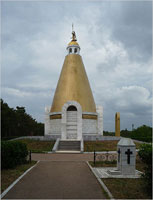 Mount Sapan
memorial to the brave defenders of Sevastopol.
Mount Sapan
memorial to the brave defenders of Sevastopol. |
| |
Thousands
of Russians still lie buried under the vast concrete bunkers.
Many
of the soldiers knew that surrender to the Nazis was not
an option so they just blew up the bunkers and were entombed
within.
|
|
|
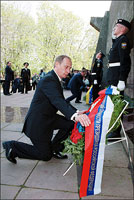 President
Vladimir Putin laying wreaths
President
Vladimir Putin laying wreaths
at a monument to the defenders
of Sevastopol, April 2000. |
When
British Secret Service agent Nikita Khrushchev became head of the Soviet
Union, he "gifted" Crimea to UKraine. The transfer merited
only a paragraph in Pravda, the official Soviet newspaper, on Feb. 27,
1954. The story was one long sentence and dense with detail. Here's
what it said:
Decree of the
Presidium of the USSR Supreme Soviet transferring Crimea Province
from the Russian Republic to the Ukraine Republic, taking into account
the integral character of the economy, the territorial proximity and
the close economic ties between Crimea Province and the Ukraine Republic,
and approving the joint presentation of the Presidium of the Russian
Republic Supreme Soviet and the Presidium of the Ukraine Republic
Supreme Soviet on the transfer of Crimea Province from the Russian
Republic to the Ukraine Republic.
And without the
Crimeans having any say in the matter, a region that is soaked in Russian
blood became part of UKraine.
The
Third Crimean War started in 2014
The Third Crimean
War began in February 2014 with a Revolution in Kiev. The lawfully elected
President, Victor Yanukovych, was ousted from office and he escaped
to Russia.
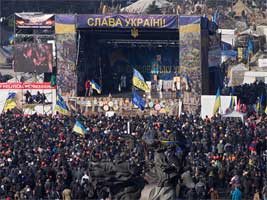 The UKrainian
Revolution ousted President Yanukovych in February 2014.
The UKrainian
Revolution ousted President Yanukovych in February 2014.
|
| |
The
UKrainian Revolution of Feb. 2014 was the work of the
British Secret Service.
They
are trying to undo their defeat in the 2 previous Crimean
Wars.
|
|
|
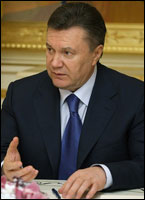 President Yanukovych
(b. 1950).
President Yanukovych
(b. 1950).
Presidentof UKraine until Feb. 2014. |
In
2010, President Yanukovych signed an agreement with Russia allowing
them to use the Sevastopol naval base until 2042. In March 2014, President
Putin saw the handwriting on the wall for the Russian naval
base unless he acted quickly.
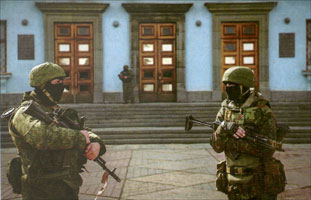 Russian airborne
troops securing key
Russian airborne
troops securing key
facilities in Crimea, March 2014. |
| |
In
March 2014, Russian paratroopers secured key facilities
in Crimea.
On
March 16, 2014, the Crimeans voted overwhelmingly to return
home to Mother Russia.
|
|
|
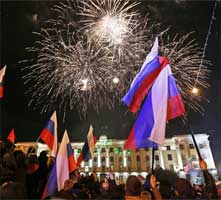 Crimeans celebrate
Crimeans celebrate
returning to Russia. |
Obviously,
the British and NATO are not going to accept the will of the Crimean
people. Since that time, a new Cold War has been rekindled by the British
and their mercenaries at the Pentagon. What their next move is going
to be is very ominous judging by their past behavior.
Vital
Links
References
Dowty,
Alan. The Limits of American Isolation: the United States and the
Crimean War. New York University Press, New York, 1971.
Forczyk,
Robert. Where the Iron Crosses Grow: the Crimea 1941-44. Osprey
Publishing. Oxford, England. 2014.
Figes,
Orlando. The Crimean War: A History. Henry Holt & Co.,
New York, 2010.
Royle,
Trevor. Crimea: The Great Crimean War 1854-1856. St. Martin's
Press, New York, 2000.
Russell,
William Howard. The
Crimean War As Seen By Those Who Reported It. Louisiana State
University Press, Baton Rouge, LA, 2009.
Copyright
© 2018 by Patrick Scrivener
Back
to Main Menu
|





 UKrainian gunboats were seized by Russian warships as they violated Russian territorial waters.
UKrainian gunboats were seized by Russian warships as they violated Russian territorial waters. 


























